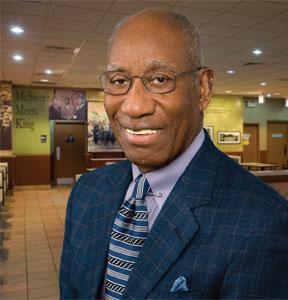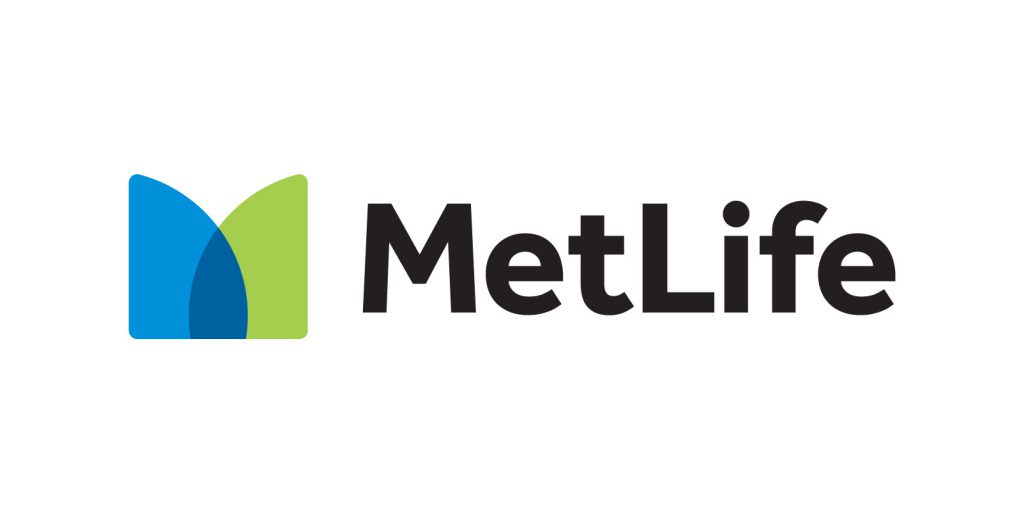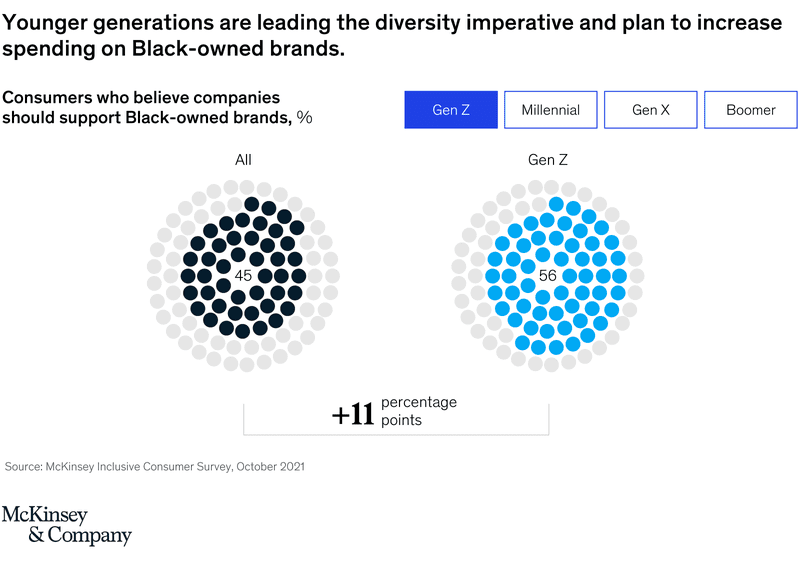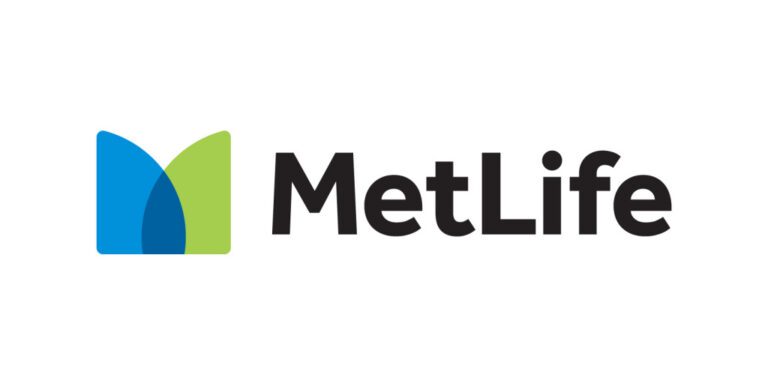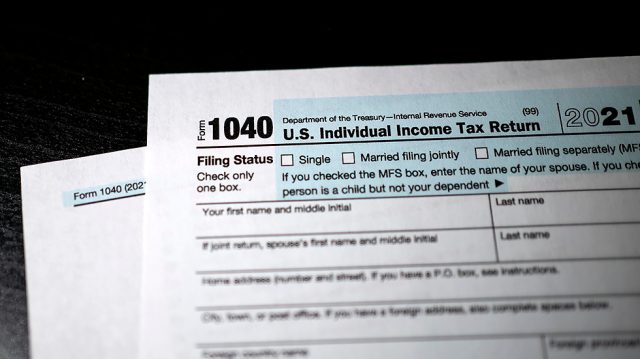Consumer demand for Black brands is rising
The age of the inclusive consumer is here. Nearly half (45 percent) of consumers in the United States agree that companies should pledge to support Black-owned brands, suppliers, and vendors. Sixty-eight percent say their social values shape their shopping choices. This sentiment is matched by the growing support for Black-owned brands by trendsetting publishers: nearly every leading fashion magazine, from Vogue to Teen Vogue, publishes lists of top Black brands and designers.
The rising demand for inclusivity on retail shelves is more pronounced when we look at the coveted Gen Z consumers, who influence over $800 billion on retail each year, as well as Black households, with consumer expenditures of around the same. In a sign of what’s to come, 90 percent of Gen Zers (those born after 1995), believe companies should address racial equality, and Gen Zers are 1.4 times more likely to say that inclusivity is one of the most important factors in their buying decisions.
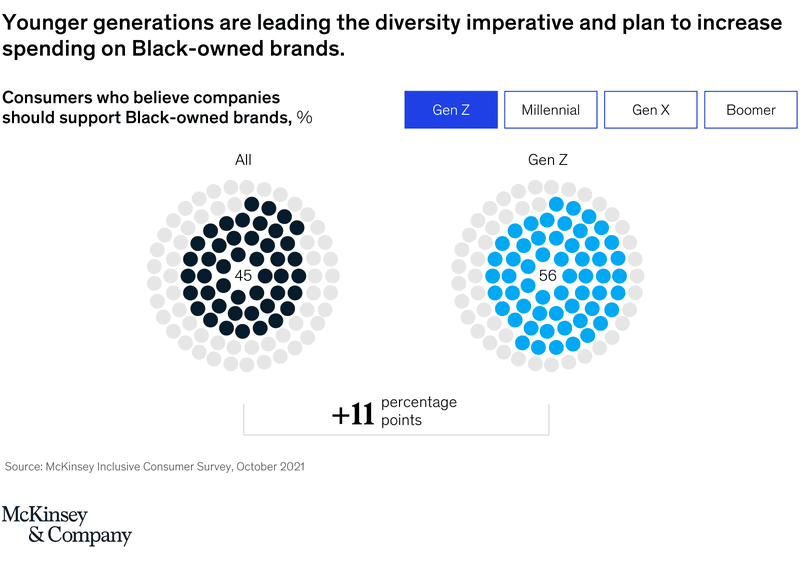
A survey of US consumers this year showed that Black consumers are far more likely to say that the products and services available today do not meet their needs, particularly in the personal care, financial, healthcare, and food industries. In the beauty industry, 92 percent of Black consumers say that supporting Black-owned brands is important to their buying decisions. Black respondents also noted that they did not see themselves in marketing campaigns, and that many companies lack a commitment to social justice. Survey results indicate that Black consumers are willing to shift about $260 billion of their annual spending to companies that better meet their needs.
Supply of Black brands is lagging due to systemic challenges
Despite rising demand and a clear consumer call for change, Black brands encounter outsize challenges to scaling and meeting the demand. While Black Americans are more likely to start businesses than any other ethnic group, they are up against tougher challenges from the get-go, with capital of only about $35,000, on average, compared with $107,000 for White entrepreneurs. Only one percent of venture-capital funding goes to Black founders,6 and many say they lack the social capital and networks they need to tap flexible capital to invest in technology, R&D, and innovation. Convincing partners and investors that products by Black-owned brands are for everyone is a battle that Black entrepreneurs face daily.
Too often, these and other barriers lead to shortfalls: just 4 percent of Black-owned businesses are still in operation after three and a half years, compared with an average of 55.5 percent for all businesses. Of the “unicorns” that have emerged in the last decade, less than 2 percent have Black founders (Exhibit 2). The last decade saw only two Black-founded unicorns in consumer retail—Pat McGrath Labs and Savage X Fenty—both brands riding the tailwinds of celebrity.9
With retail disruption in full swing post-COVID-19, leading retailers are starting to act
COVID-19 has provided a once-in-a-generation opening to reimagine how retail meets evolving consumer preferences, such as representation and inclusivity in retail. Margin pressures are rising in the retail industry, and while the pandemic has raised the stakes, it has also required retail brands to revisit strategies, marketing approaches, product and service portfolios, and more. Without the ability to lean on business as usual, retail leaders are taking steps to experiment and invest for the long term. To close the gap between supply and demand for Black-owned brands, for example, some are moving upstream to find brands instead of waiting for brands to come to them.
Amazon launched the Black Business Accelerator program in June 2021, committing to provide $150 million along with mentorship, marketing, and promotional support to Black-owned third-party sellers. Sephora invited eight brands with Black, Indigenous, and People of Color (BIPOC) founders to participate in the company’s six-month Accelerate Incubator Program, which includes “an intensive boot camp” to help participants master business skills.
These retailers are leading the way by taking hands-on approaches to help Black founders scale to meet rising consumer demands.
Competing for tomorrow: Actions retailers can take
Improving representation and diversity in the retail industry is paramount; however, finding a path to partnership that addresses systemic inequalities requires bold action across the value chain. While we focus on Black-owned brands, the following principles are applicable to other underrepresented entrepreneur populations as well. To change the game for inclusivity, retailers can take action in four main areas.
Action 1: Publicly communicate specific, tangible commitments to support Black brands
Public commitments draw a line in the sand by demonstrating seriousness and making senior leaders more accountable for results. Strong commitments can also position the organization at the front of the pack, challenging competitors to keep pace and even shifting industry dynamics. Commitments are noticed by consumers, who are savvier than ever in seeking out companies that share their values. Seventy-seven percent of Gen Zers are likely to research if a company is helping or hurting society and the environment.10
However, commitments without follow-through can backfire. Without concrete near-term goals, timelines, and measurable progress, companies risk being labeled as “diversity washing.” Similar to greenwashing, where organizations are criticized for being misleading on sustainability claims by setting goals far into the future (such as 2050), articulating vague targets (such as using “responsible” materials), and foregoing transparency (such as having opaque supply chains),11 inclusion commitments are susceptible to pitfalls like overly broad goals, lack of urgency, and narrow confinement to HR.
Companies that declare their inclusion commitment, articulate measurable goals, and publish their progress have a greater chance of success. Internally, they should define how each department will contribute to that commitment and be held accountable across the organization. While the vision is overarching, it should be supported with a mix of specific internal goals, such as increasing organizational diversity, and external goals, such as setting targets for increasing business with Black-owned suppliers and ensuring diversity in advertising.
Action 2: Take a holistic, proactive approach rather than wait and see
Setting trends takes courage, imagination, and hard work, but the alternative—moving with the herd at the pace of systemic change—is the path to irrelevance in a retail marketplace that’s changing faster than ever. This isn’t just about shelf space; rather, it is about actually meeting the rising consumer demand for inclusivity.
Many Black-owned businesses and brands are start-ups—they are not the large mass brands that retailers know how to work with. As such, forcing the same approaches and requirements on them will be ineffective. A partnership with Black-owned brands requires flexibility. And if retailers don’t anticipate and address known barriers to engagement, they will set up budding relationships to fail—a costly outcome for all involved.
Recurring themes in challenges to partnership include bias around viewing Black-owned brands as primarily providing products for Black consumers (thereby narrowing the potential audience and scope for partnership); Black entrepreneurs’ disproportionate lack of access to information about the explicit and implicit how-tos of working with a large retailer; and penalties associated with performance metrics. Combined, these factors lead to lagging confidence that a partnership would be for mutual gain.
Formalizing a partnership is just the beginning. As one director of sales put it, “You can get in, but the biggest issue is staying in. If metrics are not met, you will be removed from the shelves. The penalties of that process can take you out of business.”
Once a partnership begins, setting it up for success requires putting benchmarks in place that are not only ambitious and fair but also realistic given a brand’s context with measurement support. Blanket application of specific benchmarks with the threat of hefty fines leads to premature failure of partnerships—and can erode a retailer’s reputation, alienating future partners.
Effective partnerships also require commitment, as the timeline and path for brands to reach high sell-through numbers are different. Retailers need to invest marketing dollars, premium shelf space, and organizational support to consistently realize the rewards.
A holistic, proactive approach is required for effectively partnering with Black-owned brands to answer to the 45 percent of consumers who believe companies should support Black companies. It begins with anticipating the challenges and initiating a collaborative approach to addressing them.
Action 3: Mitigate capital constraints
For years, Black entrepreneurs have started with less capital, on average, than their non-Black competitors and had difficulty getting financing to start or grow a business. Even today, as previously noted, they start with one-third the amount of capital, are more than twice as likely to be denied financing, and are three times more likely to say that their lack of access to capital affects profitability. In 2019, even before the pandemic, almost 30 percent of Black-owned businesses spent more than half of their revenues servicing debt.
The lack of sufficient capital makes rapid growth impossible—even when an organization is profitable. Small businesses have two primary types of capital needs. The first, working capital, is cash to support the organization’s expenses from production to sales to payment. The second, innovation and growth capital, is cash to invest in new products, strategic organizational roles, and exponential growth.
Large retailers can play a meaningful role in mitigating the capital constraints by offering both educational and financing programs to suppliers.
For working capital, retailers can consider providing a portion of the payment up front, shortening the payment cycle, or supporting suppliers in accessing a range of loan options. Leading retailers may want to consider a supply-chain financing program, which allows suppliers to tap into advance payment based on the retailer’s promise to pay, without cost to the retailer.
For innovation and growth capital, any accelerator program should incorporate capital and introductions to investors, lenders, and local business networks. Black entrepreneurs have the drive, talent, and will to scale—but a great strategy without capital can go just so far.
Action 4: Don’t go at it alone
A traditional customer–supplier relationship can force smaller businesses to pursue inefficient, disjointed efforts that consume time and money and reduce the chances of success. Partnership, in contrast, can lead to more knowledge sharing and trust between large retailers and Black-owned companies and brands.
Seed investors are stepping up to help underserved entrepreneurs, and more brand owners are coming to the table expecting to have a voice—and are willing to decline deals with the wrong partners. And some new organizations and visionaries are rising to convene, build common ground and trust, and share counsel and best practices between retailers and brands.
A nonprofit called the Fifteen Percent Pledge, for example, has led major retailers to “take the pledge” to advance the representation of Black-owned brands in retail revenue, shelf space, and supplier spending. Launched in 2020, the organization offers accountability support and advice to advocate for equitable, effective partnerships between Black-owned businesses and retailers. To date, the nonprofit has helped 385 Black-owned brands reach retailers’ shelves—delivering more than $10 billion in sales in just the first six months of 2021.
As a member of the ecosystem, retailers can take a leadership role and take decisive action in response to what consumers and the broader society demand. Retailers can post their commitment, proactively remove barriers to engagement, mitigate lack of access to capital, and partner with others in the industry to drive impact. By joining together, retail can forge a new system—one that is inclusive and fosters the talent of Black and diverse founders.
As the consumer call for inclusivity in retail rises, companies have an opportunity to harness the power of retail to catapult Black-owned brands to success. Effectively doing so requires adapting the playbook—from what works with large suppliers to what works for Black-owned start-ups that daily face inequities and systemic barriers to growth. The hard work required for this effort starts with making specific and ambitious commitments, revisiting the partnership process, unlocking access to capital, and tapping resources across the industry.


